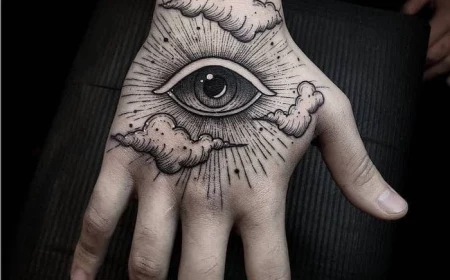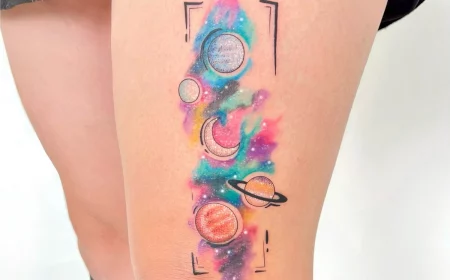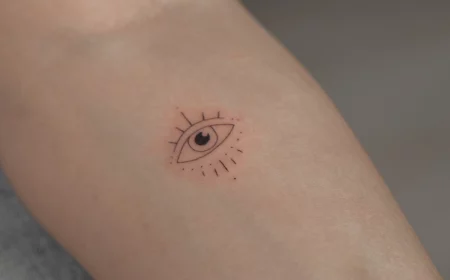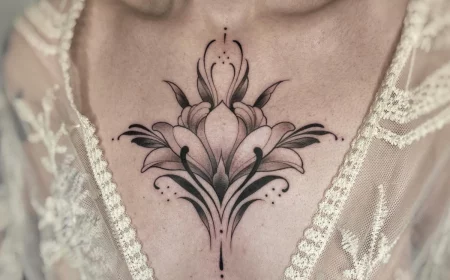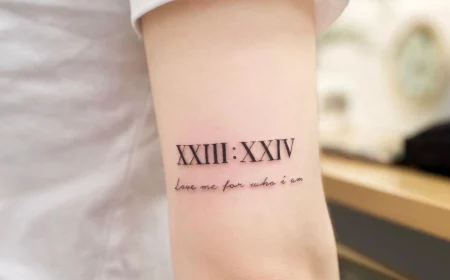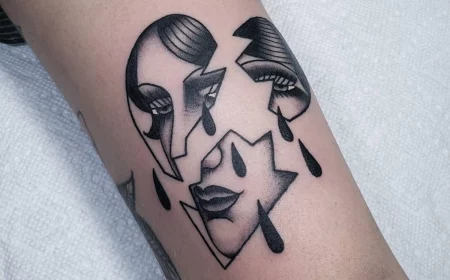Thinking About an Owl Tattoo? An Artist’s Guide to Getting It Right
In all my years slinging ink, I’ve seen just about every tattoo idea you can imagine walk through the studio door. But honestly, few designs have the timeless cool of the owl. It’s an image that just clicks with people, whether they’re a young apprentice just starting out or a grandparent celebrating a full life. The appeal is universal.
In this article
But here’s the thing: a great owl tattoo is more than just a cool picture. For the artist, it’s a serious technical test. For you, it’s a major commitment. A poorly thought-out owl can turn into a sad, blurry blob in just a few years. A well-designed one, though? That’s a stunning piece of art that will look amazing for the rest of your life.
So, my goal here isn’t just to show you cool photos. It’s to give you the inside scoop from thousands of hours with a machine in my hand. We’ll get into what makes a design work, how to pick the right style and placement, and exactly what you need to do to make sure your new owl tattoo heals perfectly and stays crisp for decades.
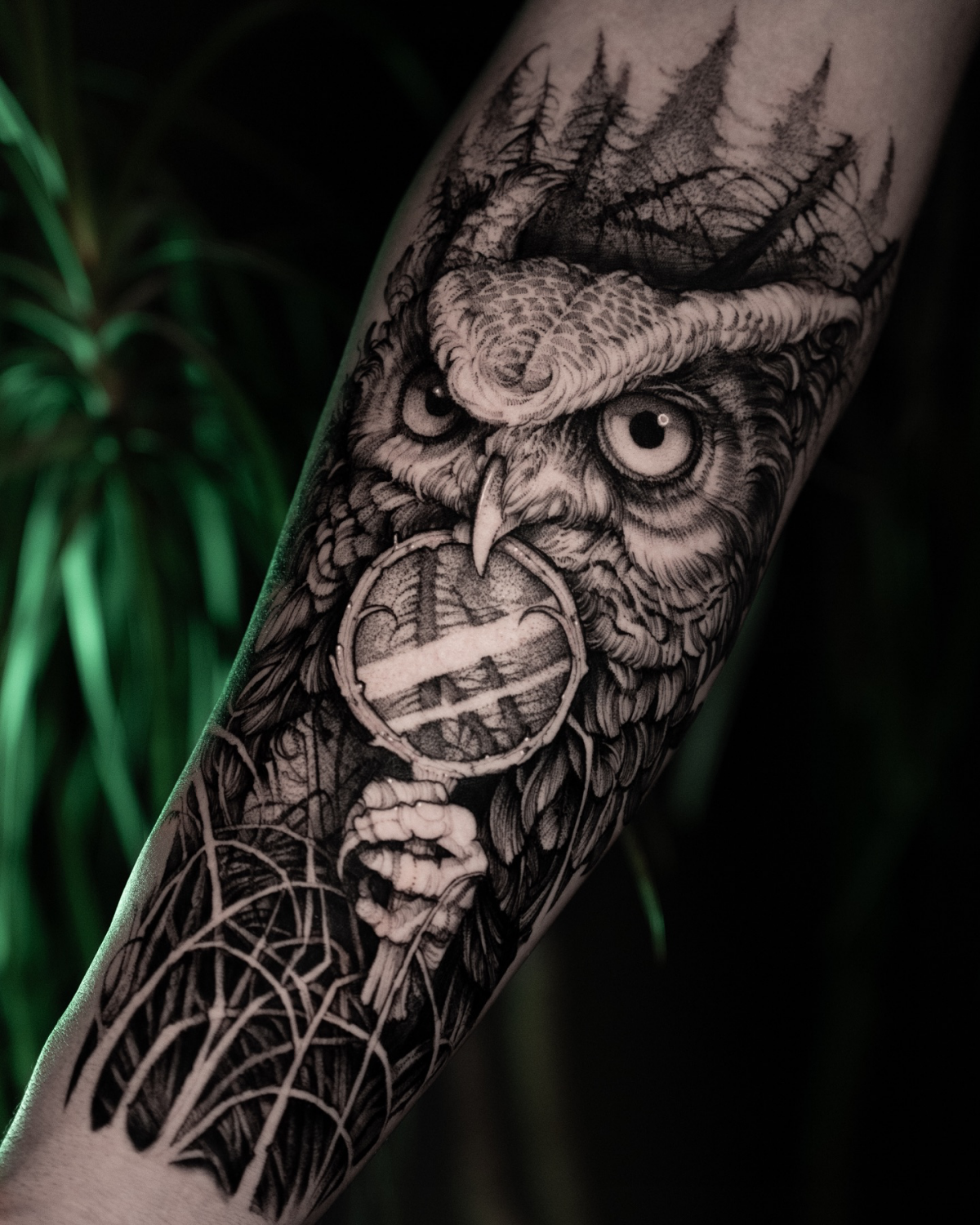
It Starts with the Bird: Why Owl Details Are Crucial
Before we even think about needles, let’s talk about the owl itself. A client might come in and say, “I want an owl,” and the first thing I’ll ask is, “Awesome, what kind?” This isn’t just me being picky about birds; it totally changes the technical approach to the tattoo.
Getting the Feathers Right
The number one challenge with any bird tattoo is making the feathers look real without turning into a muddy mess over time. Feathers have flow, texture, and layers. Here’s how we tackle different types:
- The Great Horned Owl: This is a powerhouse. It’s all about texture and mottled, complex feathers. To get this look, we can’t just draw simple lines. We often use a technique called “whip shading” with a liner needle to create the flick of individual feather barbs. For the darker, denser spots, we’ll pack in black with a magnum needle and then use layers of grey wash to build up depth. And those famous “horns”? They’re just soft tufts of feathers, so the artist has to make them look soft, not like stiff spikes.
- The Barn Owl: A completely different animal, artistically speaking. With its heart-shaped face and soft, downy chest, the approach is all about subtlety. You can’t just blast in white ink and hope it stays bright (heads up: it won’t). Instead, we use your own skin tone for the highlights. This is called using “negative space” or “skin breaks.” The artist tattoos the soft grey shadows around the light areas, creating the illusion of a pale bird. This takes a super light touch and real skill with diluted grey washes.
- The Snowy Owl: Similar to the Barn Owl, this one is a masterclass in using negative space. The magic is in the subtle bars and spots on its white feathers. A common mistake I see from less experienced artists is making these marks too dark or all the same. On skin, that just blends together over the years. A pro will use a very light grey wash and constantly change up the needle pressure to make some spots softer than others, giving it a much more natural, layered look.
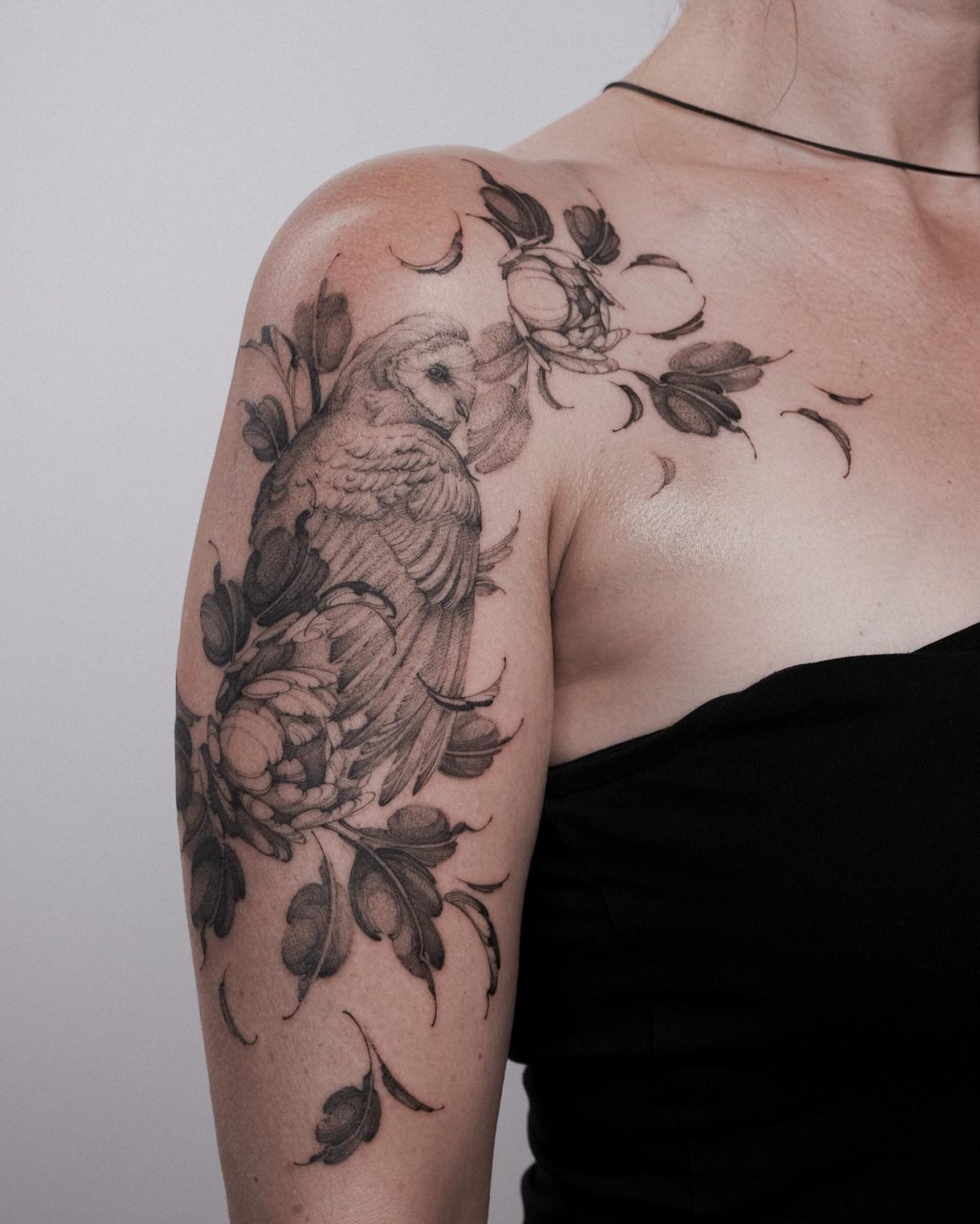
The Eyes Are Everything
Let’s be real, the eyes are almost always the focal point of an owl tattoo. They need to have that intense, wise, or even serene feeling. The trick is creating that bright, reflective pop. We’ll usually pack in a solid, vibrant color like a bright yellow or orange for the iris. Then, right at the end, we’ll add a tiny pinprick of white ink for a highlight.
Now, that little white dot will fade over time, but it makes the tattoo look incredible when it’s fresh. The real secret to long-lasting, sharp eyes is the contrast—the solid black of the pupil and the dark outline around the iris are what will keep it looking crisp and intense for years to come.
Finding Your Style: A Breakdown of Owl Tattoos
The style you pick for your owl tattoo affects everything—the technique, the price, the healing, and especially how it will look in 20 years. Each style has its pros and cons.
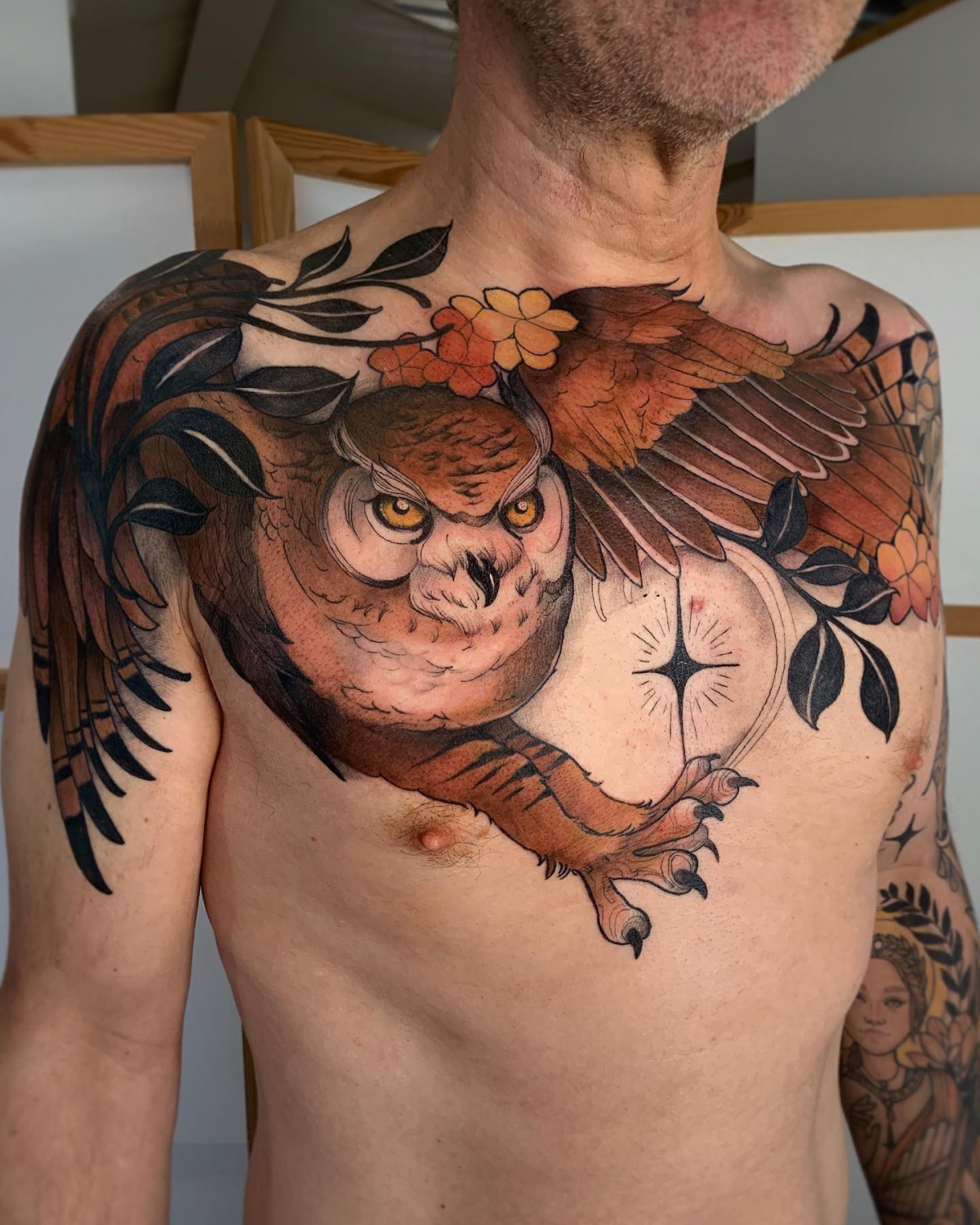
American Traditional: Built to Last
This style is all about creating a tattoo that’s tough as nails. The design is based on bold, black outlines and a palette of fully saturated, bright colors. For those thick lines, we’re using a bigger needle, and for the color, we use a steady hand to pack the pigment in solidly. There isn’t much soft shading. The result? A design that’s easy to read from across the room and will still be clear in 30 years. The heavy black outlines act like walls, keeping the colors from bleeding into each other as your skin ages. It’s a classic for a reason.
Japanese Traditional (Irezumi): Part of a Bigger Story
While it also uses bold lines and color, the Japanese style has a totally different flow. An owl here is rarely just an owl; it’s part of a larger scene. It might be perched on a maple branch to symbolize autumn, or fighting a snake to represent a clash between wisdom and passion. The background—wind, water, clouds—is just as important as the owl itself. This creates a unified piece that often covers a large area like a full sleeve or back. It’s a huge commitment of time, money, and skin, often taking dozens of sessions to finish.
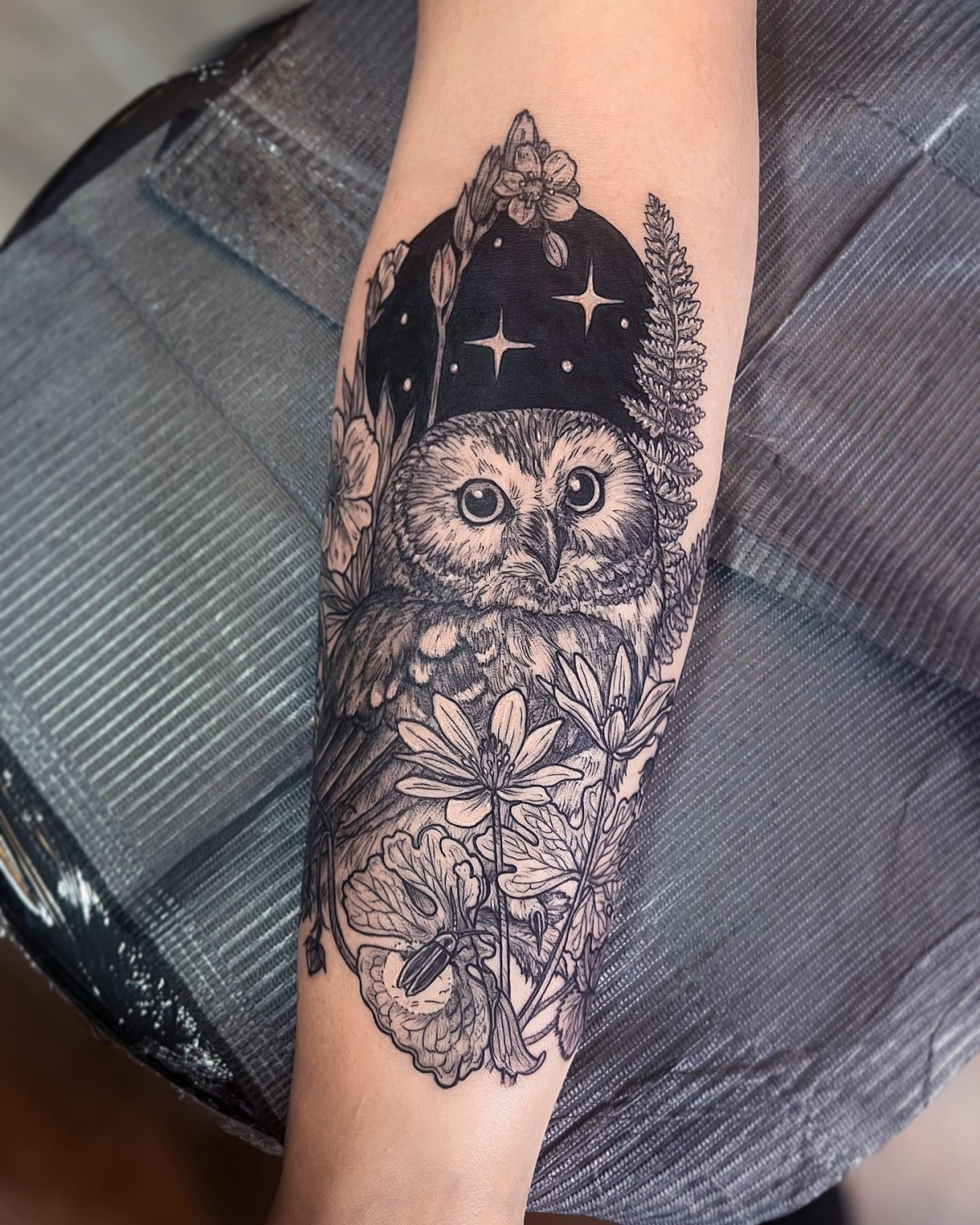
Realism: The Hard Truth
This is the style everyone sees on social media and falls in love with—a tattoo that looks just like a photograph. As a pro, I feel it’s my job to be straight with you about this one. Realism relies on soft shading and very few hard outlines. When it’s fresh, it’s breathtaking. But skin ages, stretches, and sees the sun. Those subtle grey tones can merge, and fine lines can spread. A tiny, super-detailed “micro-realistic” owl that looks amazing today can become an unrecognizable grey smudge in 5-10 years. For realism, you have to go bigger than you think. The design needs room to breathe and settle over the years so the details stay readable.
Illustrative & Neo-Traditional: The Sweet Spot
Honestly, for most people wanting a unique but durable owl tattoo, this is what I recommend. This style is the perfect middle ground. It takes the bold, lasting linework from traditional tattooing and mixes it with the more detailed shading and wider color palettes of realism. You get a solid foundation that will age gracefully, but with way more artistic freedom to add cool elements like jewels, flowers, or geometric patterns. It’s the best of both worlds.
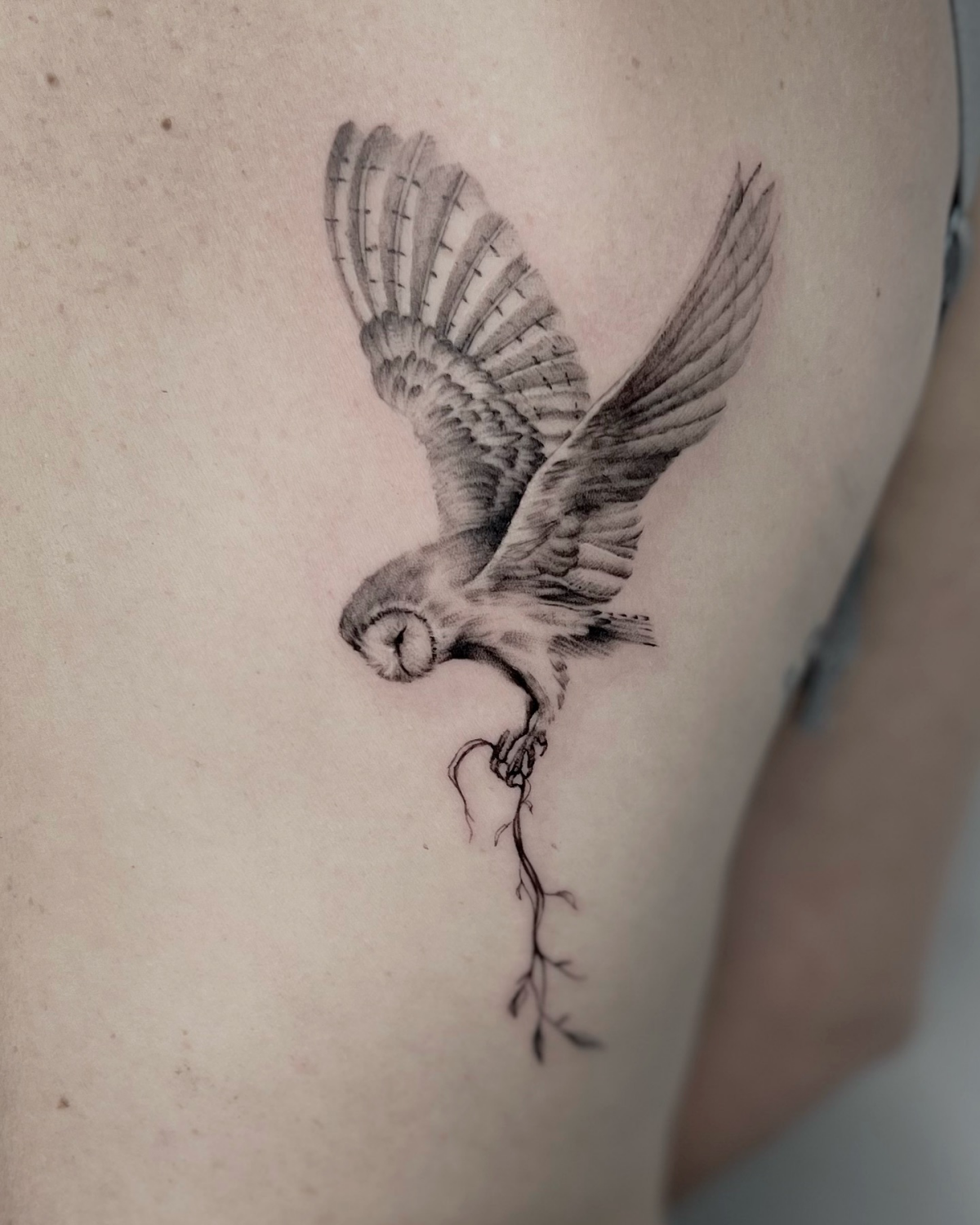
Planning Your Tattoo: The Stuff You Need to Know
A great tattoo experience starts way before you hear the buzz of the machine. It starts with a solid plan and a good chat with your artist.
Where to Put It (And What It’ll Feel Like)
Placement is everything. You have to think about the size of the owl, how it will flow with your body, and, let’s be honest, your pain tolerance.
- Big, Flat Areas (Back, Chest, Outer Thigh): These spots are perfect for large, complex designs like an owl with its wings spread wide. On a pain scale of 1-10, the fleshy part of the thigh is pretty chill, maybe a 3 or 4.
- Curved Areas (Forearm, Calf): A perched owl is great here. A good artist will design it to wrap with the muscle, so it looks good from every angle. Pain-wise, you’re probably looking at a 5-6 out of 10.
- The Spicy Spots (Ribs, Stomach, Neck): Heads up! These areas are more challenging to tattoo and to heal. On the pain scale, you’re getting into the 8-9 territory. Be real with yourself about what you can sit through before committing to a huge piece here.

How to Find the Right Artist (and Not Annoy Them)
Don’t just walk into the first shop you see. Do your homework.
First, check portfolios. Look for an artist who already does the style you want. And my biggest piece of advice: look for photos of healed work! Any tattoo can look good fresh and glossy. The artist’s real skill shows a year later. If their feed is only fresh tattoos, be a little skeptical.
Once you find someone, you’ll need to email them. A good first email makes a huge difference. Here’s a simple template:
Subject: Tattoo Inquiry – Neo-Traditional Owl
Body: “Hi [Artist’s Name], I love your work and I’d like to get a neo-traditional owl tattooed on my outer forearm. I’m thinking about palm-sized. My budget is around [give a realistic range] and my availability is generally [days of the week/times]. I’ve attached a couple of reference photos for the vibe I’m going for. Let me know if this is something you’d be interested in!”
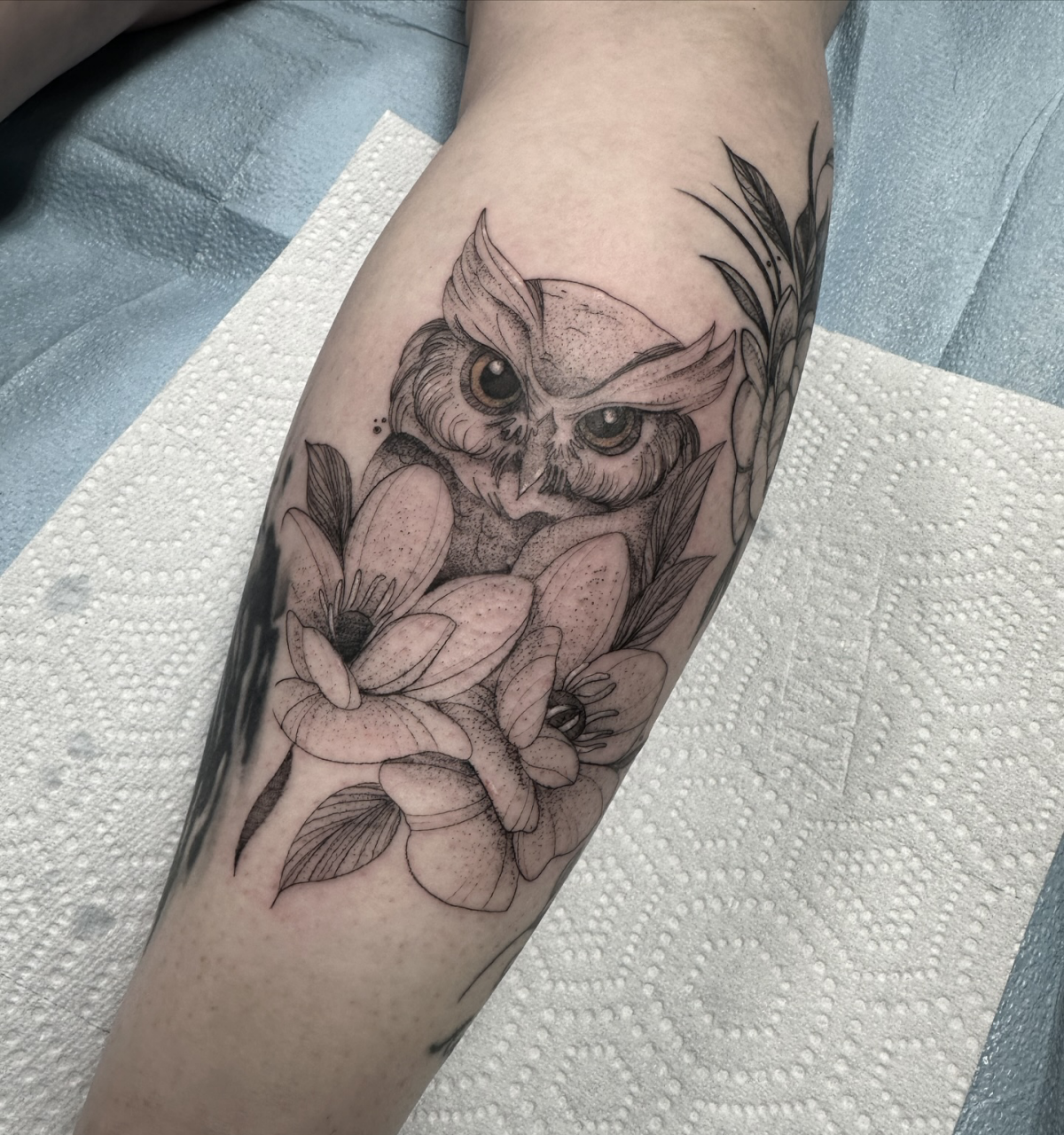
An email like that shows you’re serious and have done your research. It makes the whole process smoother for everyone.
Let’s Talk Money: Cost, Consultations & Tipping
A good tattoo isn’t cheap, and a cheap tattoo isn’t good. You’re paying for years of training, skill, and sterile, single-use equipment. So what does that actually mean? A quality artist’s hourly rate is typically somewhere between $150 and $300, depending on their location and demand. Most shops also have a minimum charge, usually around $100 to $150, even for something tiny.
So that palm-sized owl we talked about? Depending on the complexity and the artist, you should probably budget somewhere in the $600 to $1,200 range. A full back piece could be over $10,000, spread out over many months.
Oh, and one more thing that makes everyone nervous: tipping. If you love your tattoo and had a good experience, tipping 15-20% is a standard and much-appreciated gesture.

The Cover-Up: Hiding Old Ink
Owls are absolute champions when it comes to covering up old, unwanted tattoos. The rich textures and dark areas in the wings and body can hide almost anything. From my experience, it’s a game-changer for people. I once had a client with a gnarly, faded tribal armband from the nineties. We designed a big Great Horned Owl, and used the dark, dense feathers of its wing to completely swallow the old design. It took an extra couple of hours just in the planning stage, but the result was incredible. The client went from always wearing long sleeves to showing their arm off proudly. That’s the power of a good cover-up.
The Final Step: Safety and Aftercare
My job isn’t over when I put the machine down. A tattoo is an investment, and you need to protect it.
When you walk into a studio, it should be visibly clean. The artist MUST open new, sterile needles in front of you and wear gloves. If you don’t see them using plastic barriers on their chair, power supply, and wash bottles, that’s a red flag. If anything feels off, just walk out. Your health is not worth the risk.
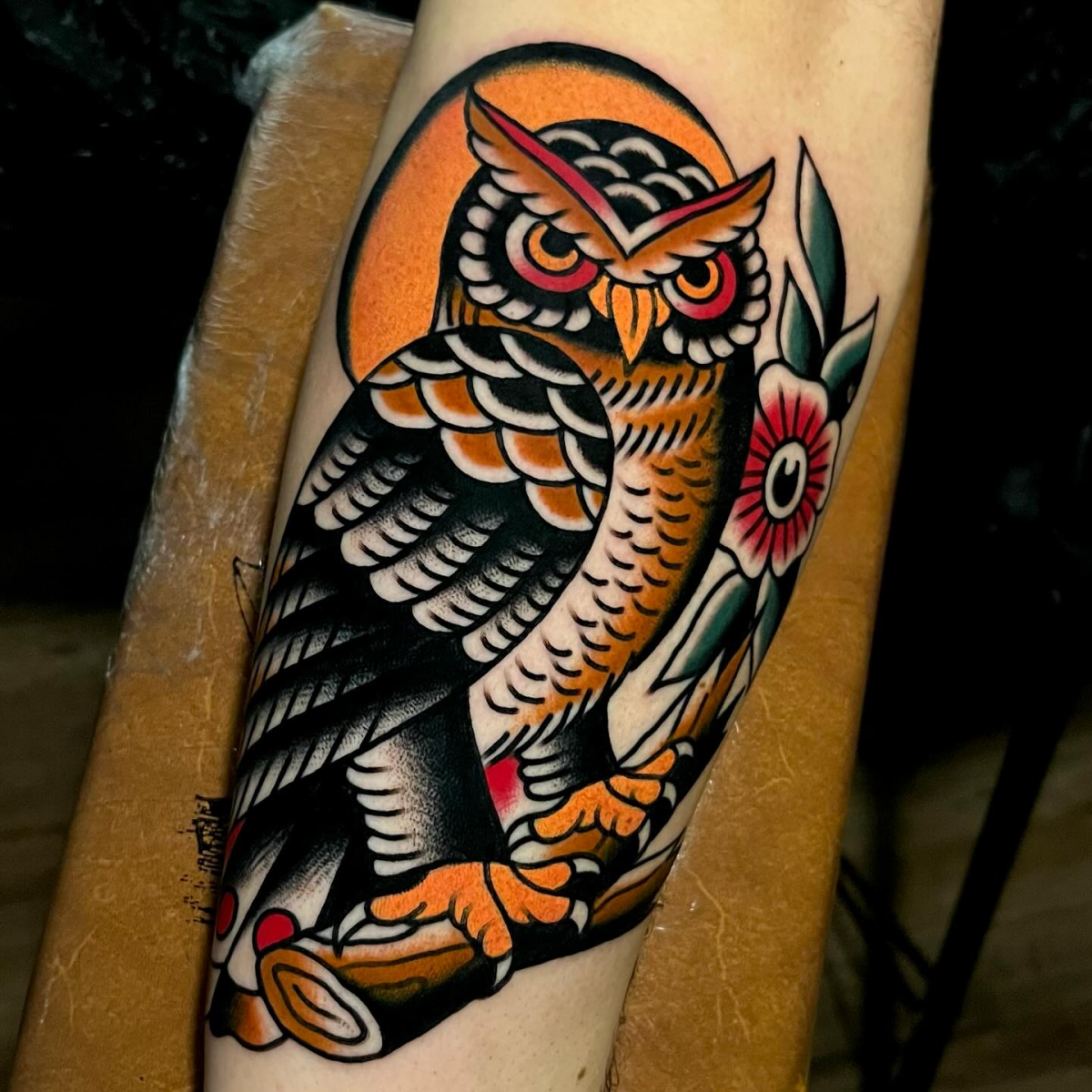
By the way, did you know the “buzzing” sound of a tattoo machine isn’t actually the needles going into your skin? That part is almost silent. The sound is the motor and the armature bar hitting the coils. Just a little fun fact for you!
How to Heal Your New Tattoo
Aftercare is simple. A new tattoo is an open wound, so treat it that way. First, you’ll need a few things, but it’s all easy to find. Grab some fragrance-free liquid soap (like basic Dial Gold, about $5), a tube of aftercare ointment (Aquaphor is a great, cheap option for around $10), and a roll of paper towels. That’s your shopping list.
- I’ll bandage your tattoo. Leave it on for as long as I tell you, usually a few hours.
- After removing the bandage, gently wash the tattoo with lukewarm water and that fragrance-free soap. Use only your clean hands—no washcloths!
- Pat it dry with a clean paper towel (don’t rub!) and let it air out for about 10 minutes.
- Apply a VERY thin layer of your ointment. It should have a slight sheen, not be a greasy mess. Over-moisturizing is a common mistake that can mess up healing.
- Repeat this wash-and-moisturize routine 2-3 times a day for about two weeks.
And the most important long-term advice I can give you? Protect your tattoo from the sun. UV rays destroy ink pigment and will turn a crisp, beautiful tattoo into a faded bruise over the years. Once it’s healed, make high-SPF sunscreen your best friend. That single habit will do more to protect your art than anything else.
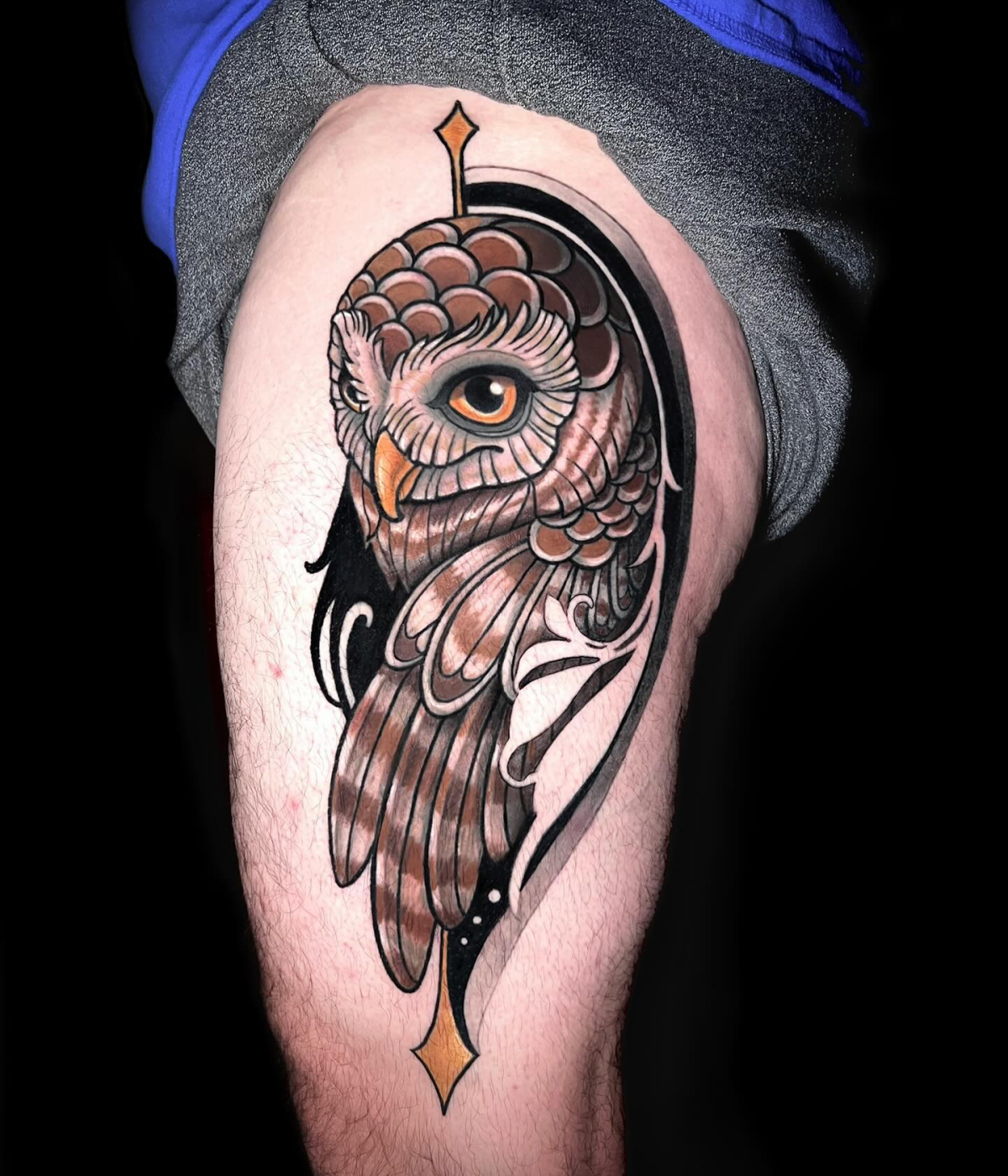
Galerie d’inspiration
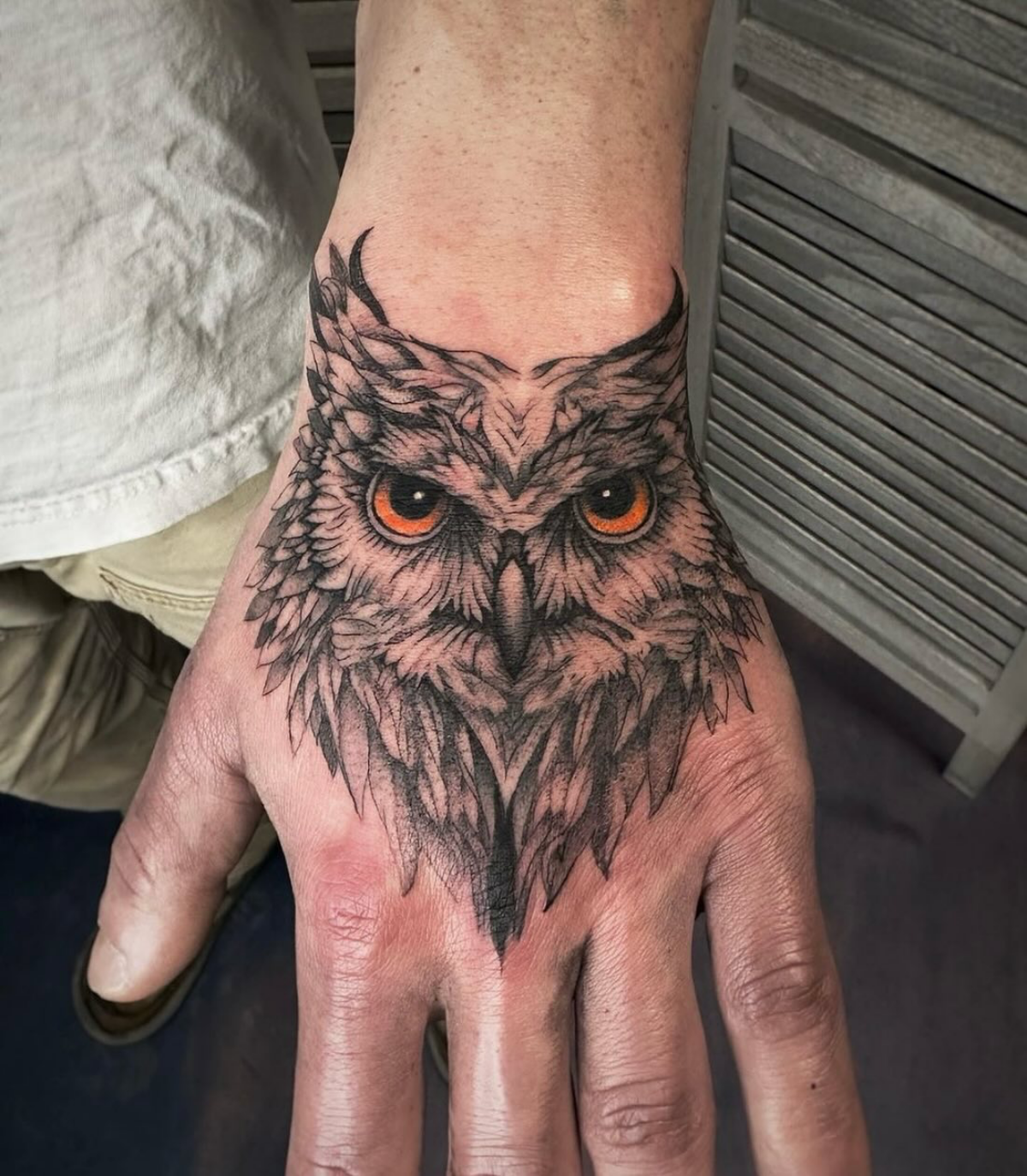
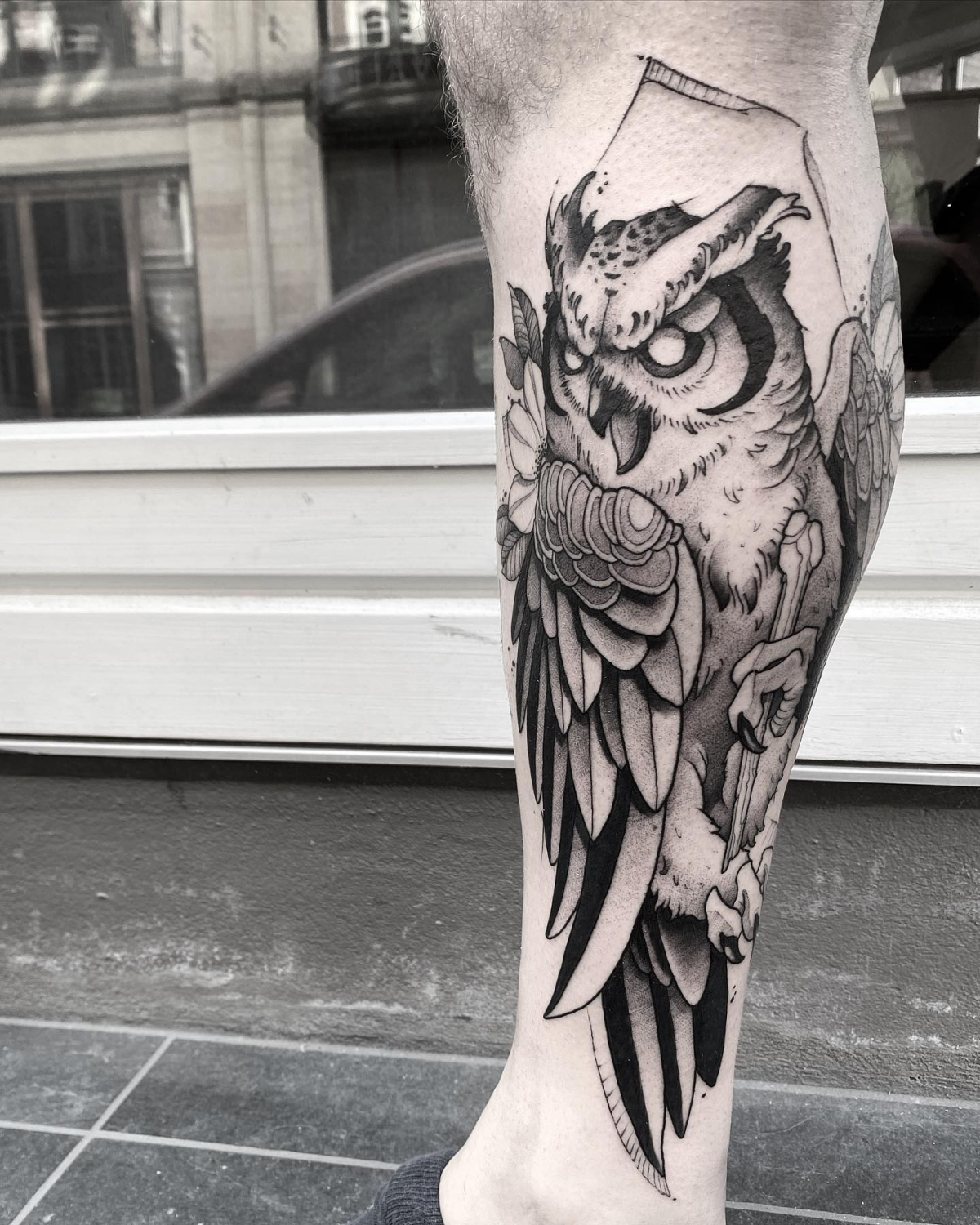
How do I find an artist who can nail a realistic owl?
Look beyond their fresh tattoo photos. Ask to see healed work, specifically pieces that are 1-2 years old. This is crucial for owl tattoos, where fine feather details can blur if not applied correctly. Check their portfolio for crisp lines, smooth shading, and high-contrast black and grey work. An artist skilled in realism, like Jesse Rix or Yomico Moreno, will proudly showcase how their tattoos stand the test of time, proving their technique is solid.
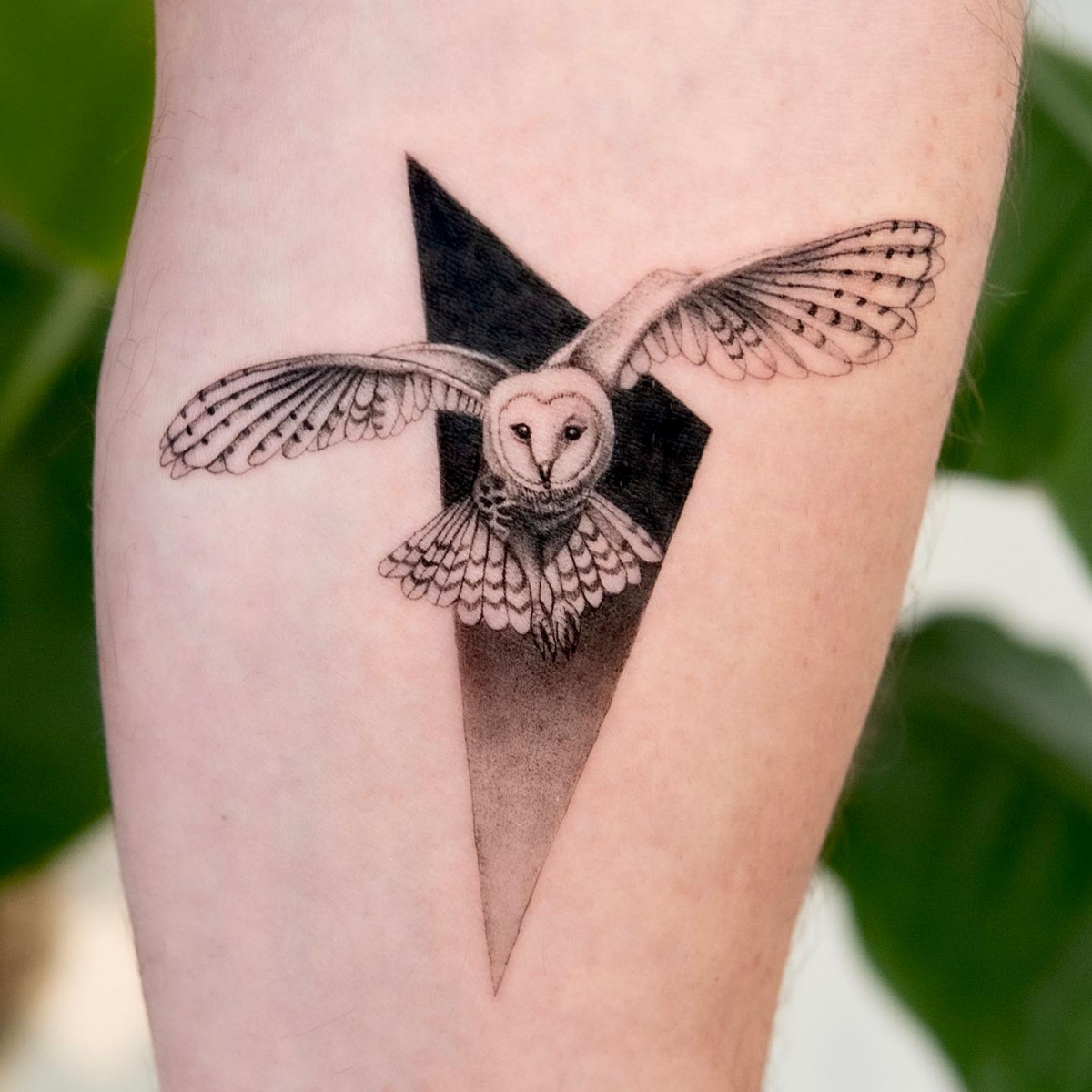
- Represents wisdom and knowledge.
- Symbolizes mystery and the nocturnal world.
- Acts as a personal totem of intuition and seeing through deception.
The power of an owl tattoo lies in its deep, cross-cultural symbolism. It’s more than just a beautiful bird; it’s a statement about the kind of energy you want to carry with you.
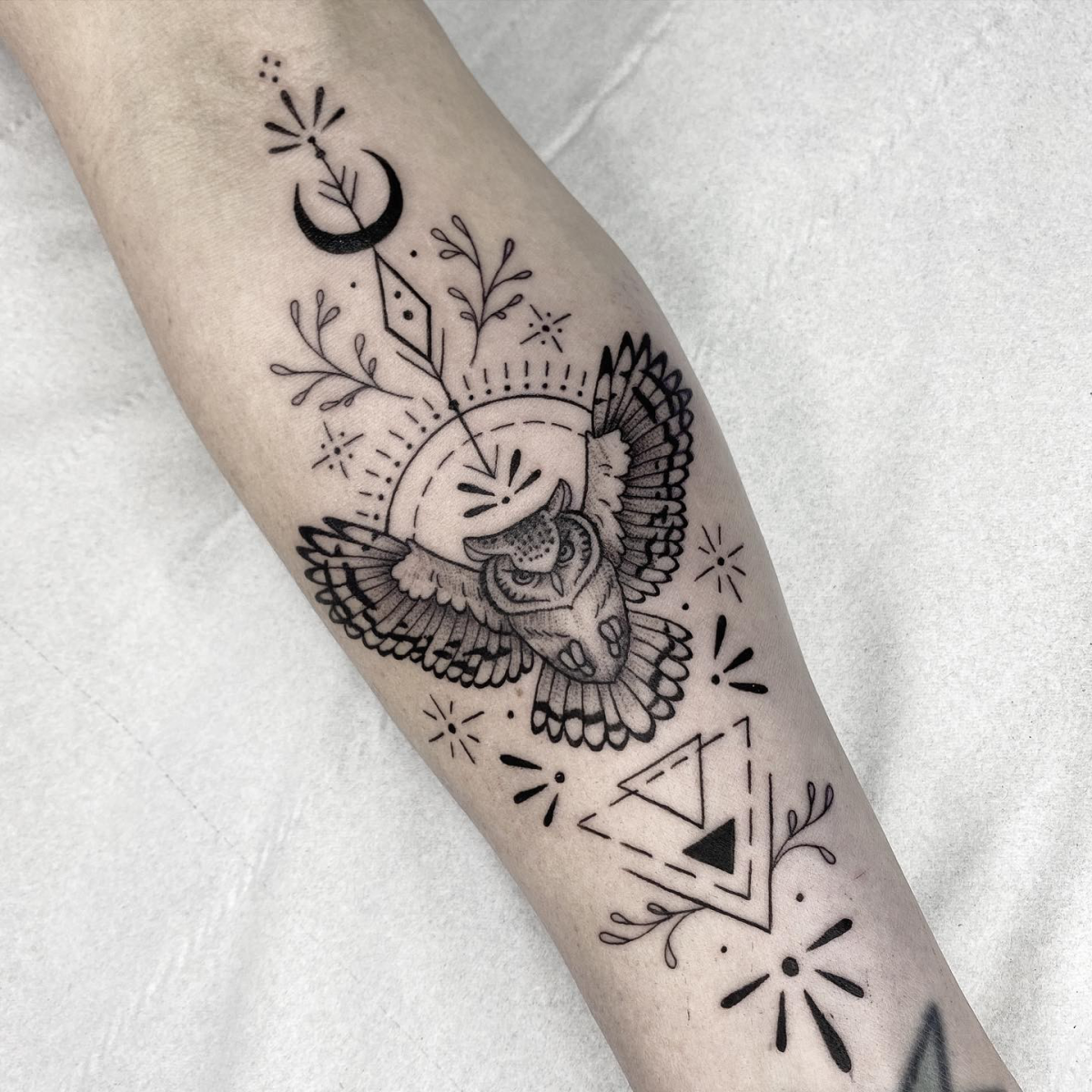
New School Owl: Characterized by vibrant, bold colors, exaggerated proportions, and cartoon-like features. Think thick outlines and a playful, almost graffiti-art feel. It’s perfect for a statement piece that pops with personality.
Japanese (Irezumi) Owl: This style is rich in tradition, using a more limited color palette with strong black backgrounds, wind bars, and symbolic pairings like cherry blossoms or maple leaves. The focus is on flow, power, and fitting the body’s contours.
Your choice depends on whether you want expressive energy or classic, powerful storytelling.
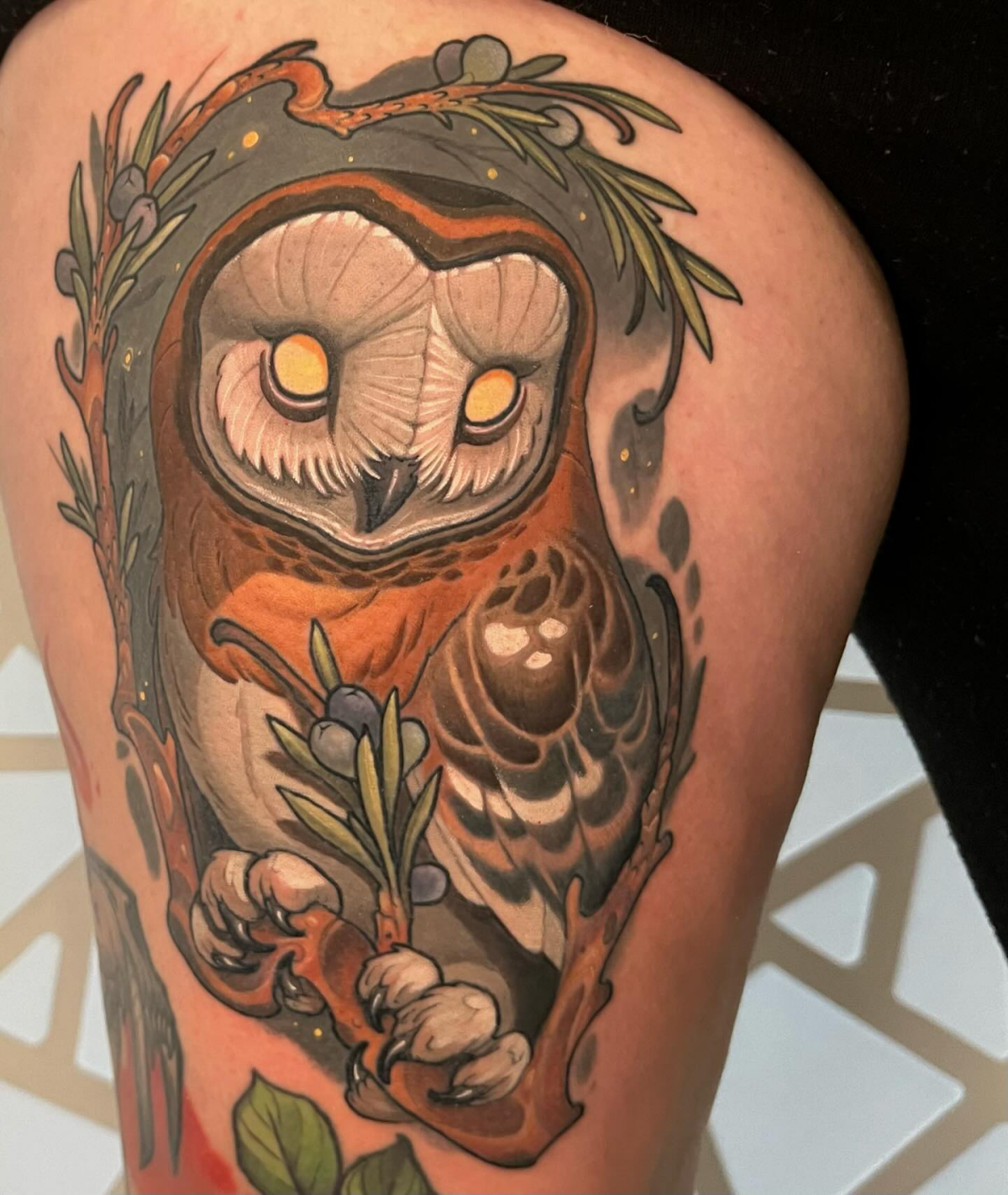
A critical point on placement: An owl’s face is defined by its symmetry and piercing gaze. Placing it directly on a high-movement joint like an elbow ditch or the top of the knee can cause the design to warp and distort with every bend. A skilled artist will always recommend a flatter, more stable area like the forearm, calf, or thigh to preserve the integrity of the portrait for years to come.
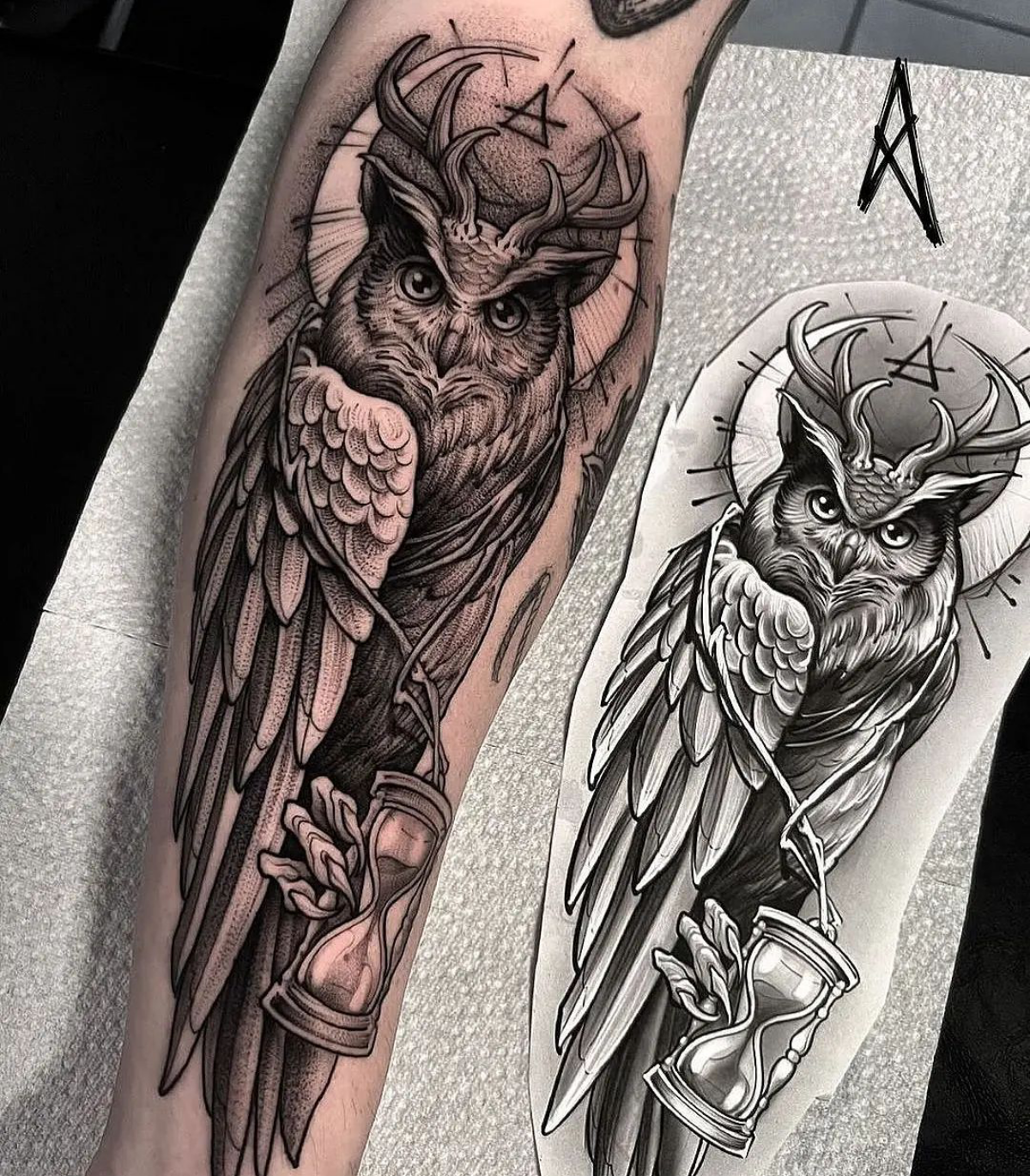
In ancient Greece, the Little Owl (Athene noctua) was the sacred companion of Athena, the goddess of wisdom, and was often depicted on coins as a symbol of intelligence, status, and wealth.
This historical connection is why the owl remains one of the most powerful intellectual symbols in Western tattooing. Choosing an owl is tapping into millennia of respect for its silent, observant nature.
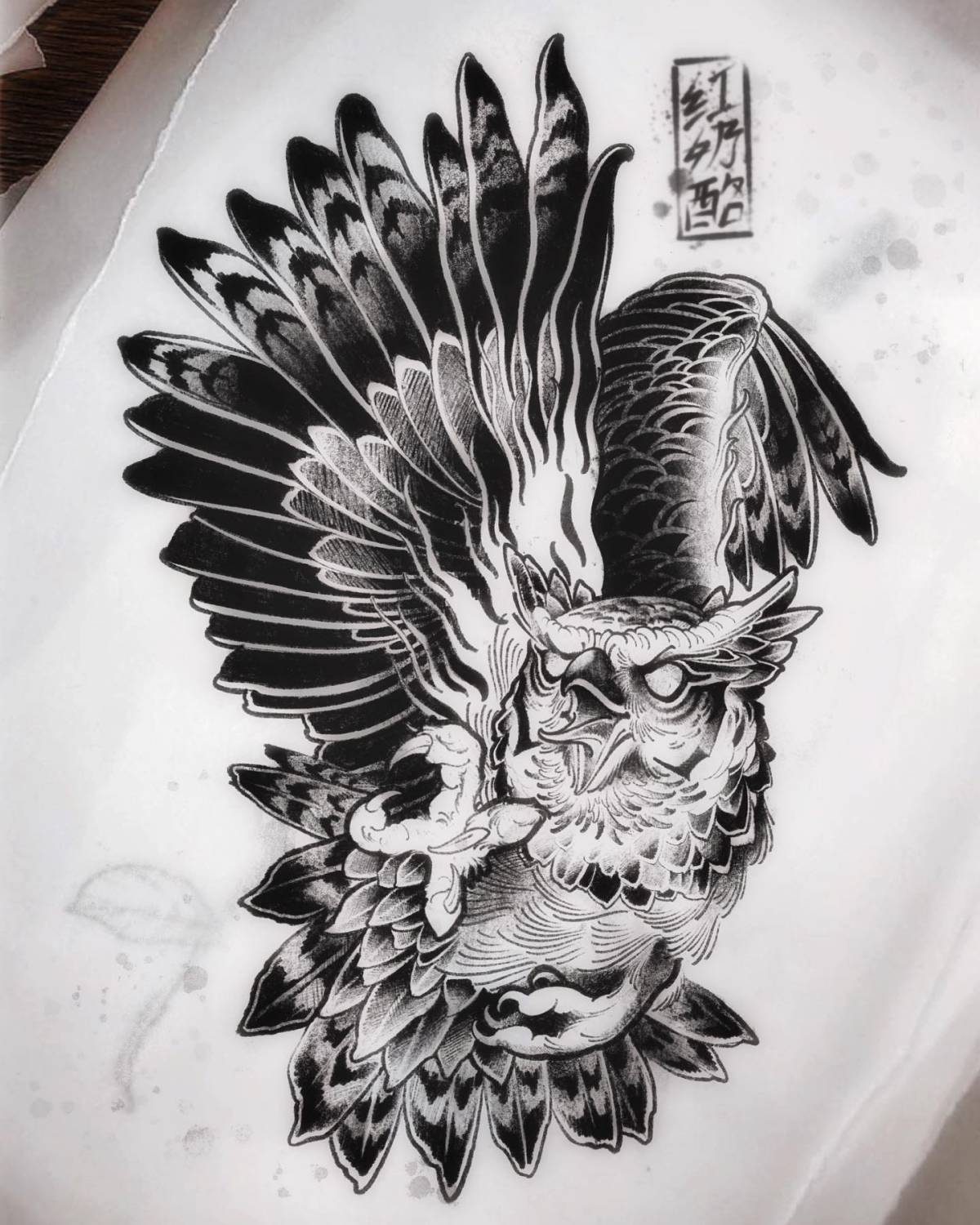
The long-term vibrancy of your owl’s feathers and the sharpness of its eyes depend heavily on sun protection. Once healed, daily application of a high-SPF sunscreen is non-negotiable. For tattoos, mineral-based sunscreens containing zinc oxide are often recommended as they create a physical barrier. Brands like Mad Rabbit or CeraVe offer fragrance-free options that won’t irritate the skin while preserving the ink’s contrast and color.
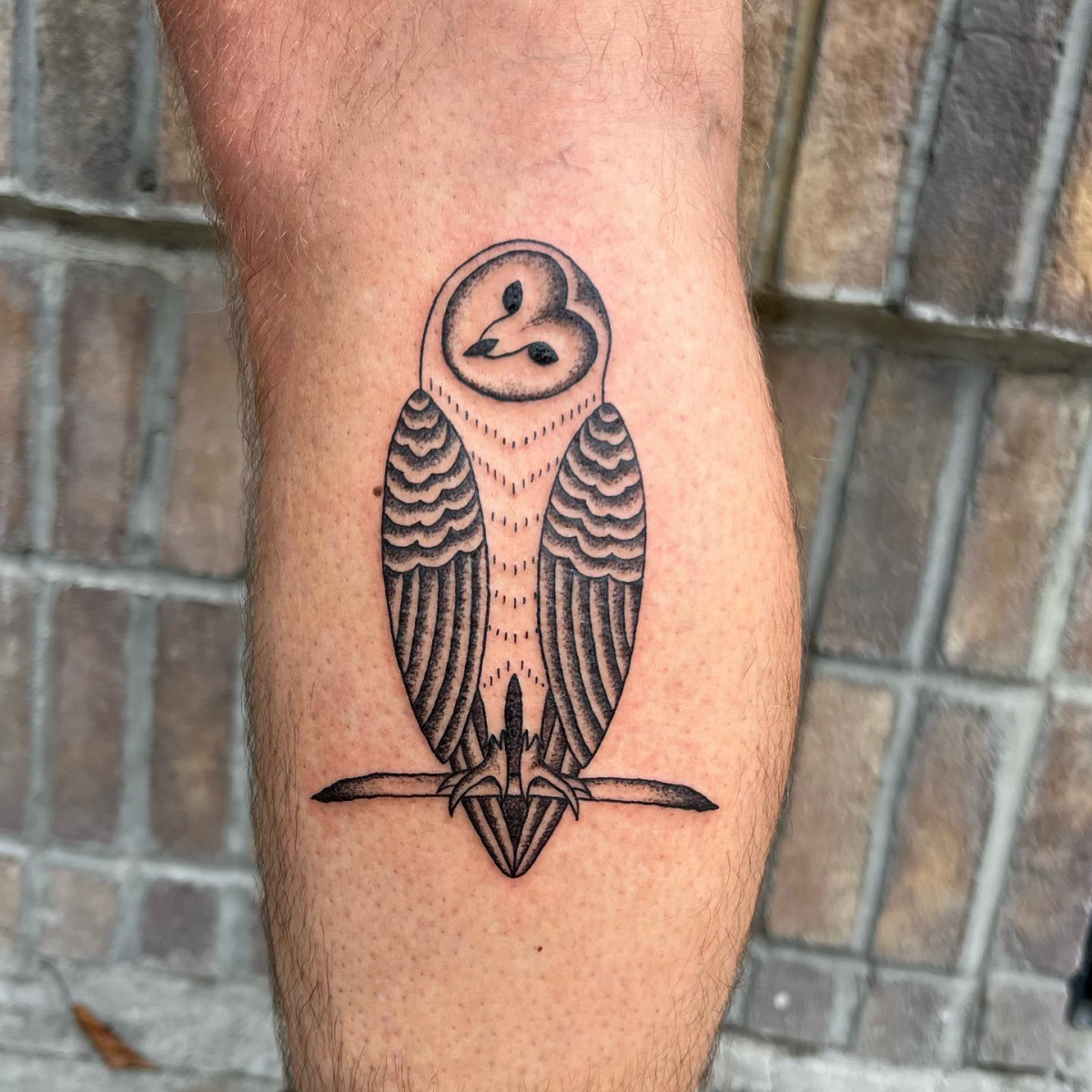
When you meet your artist for a consultation, come prepared. This simple step can transform a good tattoo into a great one.
- Bring 3-5 high-resolution reference photos of the owl species you love.
- Include images of tattoo styles you admire (realism, neotraditional, etc.).
- Take a photo of the exact placement on your body, clearly marked.
- Have a list of any other elements you want to incorporate, like clocks, keys, or botanicals.
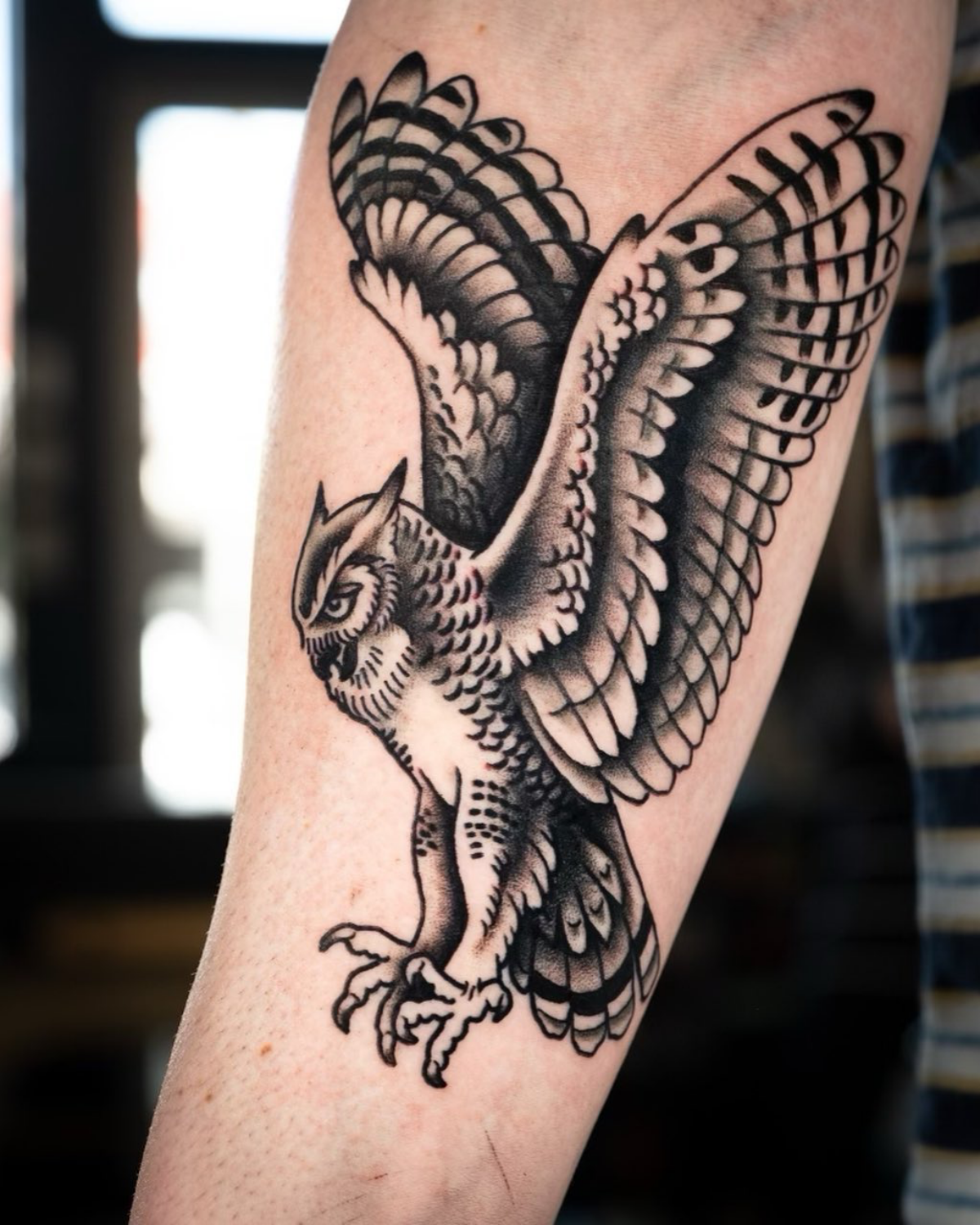
The geometric owl trend is a fantastic way to blend nature with modern aesthetics. It combines the organic shape of the bird with crisp lines, mandalas, and abstract patterns. This style works exceptionally well for those who appreciate the owl’s symbolism but prefer a less literal, more stylized interpretation on their skin. It’s a design that feels both ancient and futuristic at the same time.
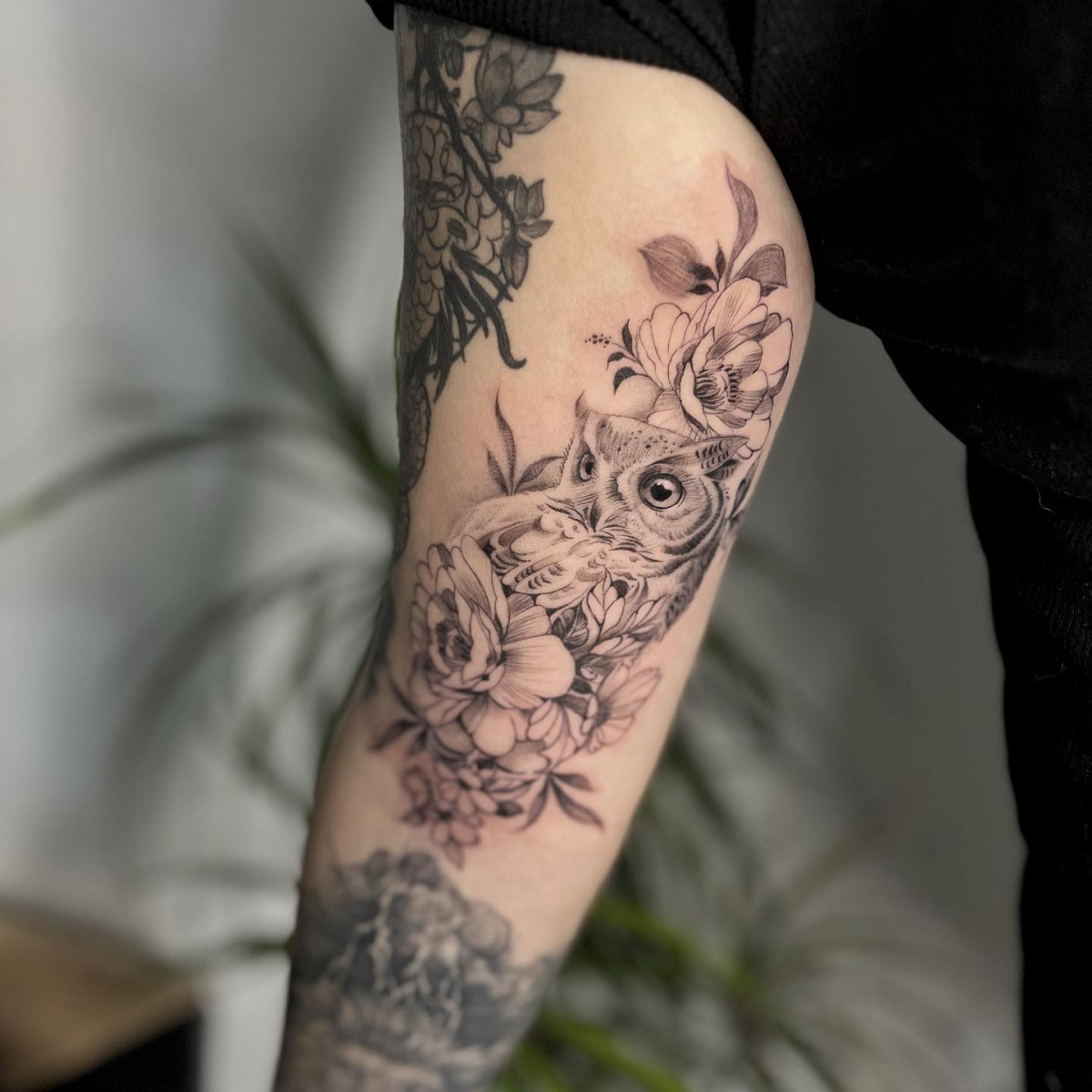
A single session for a detailed, palm-sized black and grey owl tattoo can involve over 100,000 individual needle punctures.
This isn’t just about pain; it’s about the artist’s precision. Each puncture deposits a minuscule amount of ink. For delicate feathers and sharp eyes, the artist uses different needle groupings—tight liners for outlines and various magnums for soft shading—to build the image layer by layer. It’s a testament to the technical skill required for a seemingly simple design.
Thinking about color?
While many owl tattoos lean into the drama of black and grey, adding specific colors can deepen the meaning. A touch of deep blue in the feathers can symbolize mystery and the night sky. Splashes of autumnal orange or yellow can represent wisdom and the harvest season. Discuss these color pops with your artist; even a small amount, like the golden yellow in the owl’s eyes, can completely change the mood of the piece.

